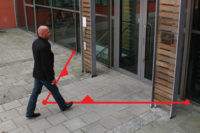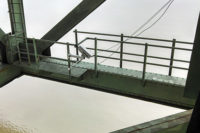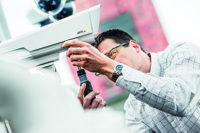Powered Up
At the foundation of a well-functioning video surveillance system are the cable, power supplies and media converters.






When talking about video systems, any discussion of cabling is undoubtedly intertwined with a discussion about power and power supplies. This is especially true when the conversation steers towards running power and video signals over the same wire, whether using power over Ethernet (PoE) or another type of cable.
“There’s a big shift from AC power supplies, DC power supplies,” says Gene Pecora, director of marketing for Honeywell Fire and Safety, and former general manager of Honeywell Power Products. “On top of that, there’s the whole PoE, which is a little different. There’s a whole new set of standards, a new set of cameras. It kind of started in the casino environment and then branched out from there.”
Driven by increased energy demands of today’s cameras, this blending of streams is becoming more and more prevalent, Pecora says. IP cameras have certainly changed a lot of the concepts about power and cable, but when it comes to increased power requirements, infrared (IR) technologies lead the charge.
“It used to be common that a bullet camera would draw ¼ amp. Today, an IR camera that covers the same area — only with IR — is drawing ¾ amp. That puts a much different demand on the power supply,” he says.
Cable comes in several flavors: coaxial, twisted pair, composite and fiber optic, each with its own pros and cons, particularly in the realm of IP video. Coax is economical and its design naturally protects video from electromagnetic interference, preserving a clean signal. For most installations, RG59 will work, but longer runs may require RG6. Coax can be used for IP systems by using media converters (see sidebar on next page), but for the most part, it’s only ideal for analog video.
Twisted pair is ideal for IP video. Cameras using PoE require only common Cat 5e or Cat6 cables for both video and power. These cables, as well as other composite designs that incorporate wiring for both video signal and power, eliminate the need to run extra wires to power cameras — allowing for a faster installation. The downside of composite cables is that, unless extenders are used, cable run lengths are more limited than with coax. More feature-rich cameras, such as those with heaters or PTZ capabilities, may require more power, so a composite UTP and power cable is best.
While the majority of systems use coaxial or twisted pair cables, that trend may change in the near future, says Dan Dunar, application engineer for Honeywell Cable (formerly Genesis Cable), based in Pleasant Prairie, Wis.
“Traditional analog systems have used coaxial cables for many years, but growth in IP video systems has shifted some of the demand to twisted pair cables,” he says. “With continued growth of IP video and PoE cameras, demand for Cat 5e and Cat 6 cables for video will grow.”
Because about 80 percent of analog cameras were installed using coax, Ethernet over coax (EoC) is another option that may be more economical for a customer looking to make the switch to IP, says Guy Apple, vice president of marketing for Menlo Park, Calif.-based NVT. Because EoC takes advantage of existing coaxial cable, it can save time and labor costs, minimize the disruption that a rip-and-replace project would cause, and — perhaps less well-known — it also could prevent legal issues and fines.
“In some states, leaving unused cable in place that isn’t connected at both ends is not legal,” Apple says. “National Electrical Code rules 800.2 and 770.2 prohibit the abandonment of unused cable, and removal and disposal or recycling of existing cable is expensive.”
By using a transceiver, EoC-based PoE provides 48V of power in one location, such as a control room. This power can be distributed to the EoC transceivers and IP cameras without requiring repeaters. This also extends the maximum distance at which PoE is effective far beyond its 328-foot limitation.
Power to the People
On the topic of power, there are a wide variety of power supplies available for use in video systems. Features vary depending on the specific requirements of a system and include mounting type, voltage/power output, individual device current/total current and number of outputs.
“The power supply follows the camera. A lot of cameras are going DC today, but you also have outdoor cameras, which drive outdoor power, depending on where they’re placed to put the power supplies on a building,” Pecora says.
For analog installations, a traditional multi-output wall- or rack-mounted power supply often is the right choice. For those installations using UTP, there are power supplies that inject power over the same cable as video and data, which can be an efficient installation solution. PoE systems tend to use midspans.
Today, there’s still a high demand for 12VDC and 24VAC power supplies, says Ronnie Pennington, national accounts manager for Brooklyn, N.Y.-based Altronix Corp. However, there has been a shift to PoE midspan injectors as that technology becomes more prevalent. There’s also a growing demand for uninterrupted power supplies (UPS), which ensure continuous camera operation during power outages or other power conditions.
“Without power, there is no video. It’s critical to have efficient distributed power where and when you need it,” he explains.
Going the Distance
While cable selection should primarily be based on the type of cameras and monitoring or recording equipment in a system, the cable’s run length also requires careful consideration. Below are the maximum distances (without using additional power supplies or extenders) for the most common cable types.
- Coaxial: Up to 750 feet (RG59) or 1,500 feet (RG6)
- Coaxial with copper clad aluminum: Up to 600 feet
- Mini coax: Up to 375 feet
- Power over Ethernet: Up to 328 feet
Media Converters: Why & How
In video systems, media converters also figure into the relationship between both cable and power supplies.
At the most basic level, a media converter is a device that changes Ethernet signals traveling on copper cable into Ethernet signals that run on a fiber-optic network, allowing fiber to be added to a network without any other changes. And because they operate on the physical level of a network, they are incredibly network-friendly, says Ed Davis, president of American Fibertek, based in Somerset, N.J.
“They receive data signals from one media and convert them to another media while remaining transparent to data traffic and other network devices,” he says.
Media converters also allow for longer wire runs that go beyond the limitation of the three cable types they work with: fiber, coaxial and twisted pair.
“Distance is always the key. The worst thing you can do is not have enough bandwidth for the distance you plan to cover,” says Skip Haight, vice president of marketing for Danbury, Conn.-based ComNet.
For video systems, an increasing use of media converters is to allow Ethernet signals to be transported over existing coaxial cable. So it shouldn’t be surprising that in today’s market, IP Ethernet and PoE media converters are at the front of the demand curve. Both convert an IP-based signal on twisted pair to a fiber optic signal. PoE converters offer the additional function of injecting the twisted pair with the power necessary to operate remote IP cameras.
“The conversion from analog to IP video has not happened as rapidly as some were predicting a few years ago, but interest in the technology has grown over the last year-plus especially,” says Jacob Pomplun, marketing manager for Transition Networks, based in Minnetonka, Minn. “A lot of these cameras are not at copper-permitted distances, and media converters with PoE allow users to combine power and data without an extra power run.”
The most common vehicle for media converters is an RJ-45 connector to fiber via any number of common connector types (typically SC, ST and LC), according to Nick Paredes, product manager for Bothell, Wash.-based Allied Telesis. This demand is driven by cost, ease of installation and the move to IP. “It’s much more desirable to use existing coax or twisted pair cabling instead of running new Cat 5 or Cat 6 cable,” he says.
Another familiar culprit is also driving the rise in popularity of media converters, Davis says. “In a word, bandwidth. The requirement for more bandwidth is largely due to the growing popularity of megapixel cameras,” he says.
Luckily, Davis describes, converters are incredibly easy to install, as simple as patch cables or connectors. And with many compatible with simple network management protocol (SNMP), they also can be easy to manage.
When coupled with the right cable and power supplies, media converters can offer additional functionality beyond translating video signals and extending wire runs. These can include transporting serial information needed to control PTZ cameras or even providing a way to transport video over an Ethernet-based local area network (LAN).
All functionality aside, the greatest considerations for choosing the right media converter for a particular project are required bandwidth and distance the signals will be transmitted. And as new technologies are introduced, distance may become less of a factor for PoE (which is currently limited to 750 feet), Haight says.
“Through a fiber optic media converter, you can take an electrical signal and convert it to light and go kilometers and kilometers and kilometers over fiber,” he says.
Looking for a reprint of this article?
From high-res PDFs to custom plaques, order your copy today!











